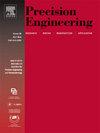The structure optimization of aerostatic bearings with radial wedge grooves to improve static Performance: Theoretical predictions and experimental measurements
IF 3.5
2区 工程技术
Q2 ENGINEERING, MANUFACTURING
Precision Engineering-Journal of the International Societies for Precision Engineering and Nanotechnology
Pub Date : 2025-05-06
DOI:10.1016/j.precisioneng.2025.05.001
引用次数: 0
Abstract
Aerostatic bearings play a vital role as a fundamental support component in ultra-precision manufacturing and measuring equipment. However, due to the air compressibility, the loading capacity and stiffness of aerostatic bearings are lower than that of traditional bearings, which limits their application in high-precision manufacturing fields. This study introduced a novel design of aerostatic bearing with radial wedge grooves (RWG) aimed at enhancing static performance. The influence of RWG structural factors on the static performance of aerostatic bearings was examined using computational fluid dynamics (CFD). Three-dimensional large eddy simulation (LES) methods were used to examine the transient flow properties of aerostatic bearings with three distinct structures. To confirm the correctness and validity of the CFD model, experimental measurements of the static performance and micro-vibration in aerostatic bearings with three different wedge groove structures were carried out. The results revealed that the loading capacity of aerostatic bearings with RWG gradually increased with the increase of the groove radial angle θ and groove wedge angle γ, exhibiting an initial rise followed by a subsequent decrease with an increase in groove radius. Furthermore, the stiffness of aerostatic bearings demonstrated progressive improvement with an increase in wedge groove radius, groove radial angle and groove wedge angle. The mass flow rate of aerostatic bearings shows an increase as the wedge groove radius, groove radial angle, and groove wedge angle are increased. This study presents new insights into the application of aerostatic bearing in grooves throttling.
径向楔槽空气静压轴承的结构优化以提高静力性能:理论预测和实验测量
在超精密制造和测量设备中,空气静压轴承作为基础支撑部件起着至关重要的作用。然而,由于空气可压缩性,空气静压轴承的承载能力和刚度低于传统轴承,这限制了其在高精度制造领域的应用。为提高静压轴承的静力性能,提出了一种径向楔槽静压轴承的设计方法。采用计算流体力学(CFD)方法研究了RWG结构因素对静压轴承静力性能的影响。采用三维大涡模拟(LES)方法研究了三种不同结构的静压轴承的瞬态流动特性。为了验证CFD模型的正确性和有效性,对三种不同楔形槽结构的空气静压轴承进行了静力性能和微振动的实验测量。结果表明:随着沟槽径向角θ和沟槽楔角γ的增大,RWG静压轴承的承载能力逐渐增大,随着沟槽半径的增大,其承载能力呈现先上升后下降的趋势;随着楔形槽半径、楔形槽径向角和楔形槽角的增大,静压轴承的刚度逐渐提高。静压轴承的质量流量随着楔形槽半径、槽径向角和楔形槽角的增大而增大。该研究为静压轴承在沟槽节流中的应用提供了新的见解。
本文章由计算机程序翻译,如有差异,请以英文原文为准。
求助全文
约1分钟内获得全文
求助全文
来源期刊
CiteScore
7.40
自引率
5.60%
发文量
177
审稿时长
46 days
期刊介绍:
Precision Engineering - Journal of the International Societies for Precision Engineering and Nanotechnology is devoted to the multidisciplinary study and practice of high accuracy engineering, metrology, and manufacturing. The journal takes an integrated approach to all subjects related to research, design, manufacture, performance validation, and application of high precision machines, instruments, and components, including fundamental and applied research and development in manufacturing processes, fabrication technology, and advanced measurement science. The scope includes precision-engineered systems and supporting metrology over the full range of length scales, from atom-based nanotechnology and advanced lithographic technology to large-scale systems, including optical and radio telescopes and macrometrology.

 求助内容:
求助内容: 应助结果提醒方式:
应助结果提醒方式:


